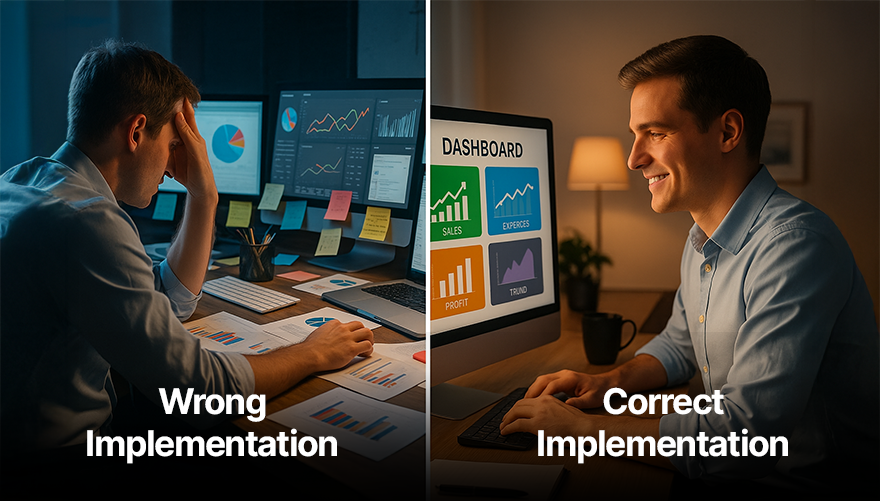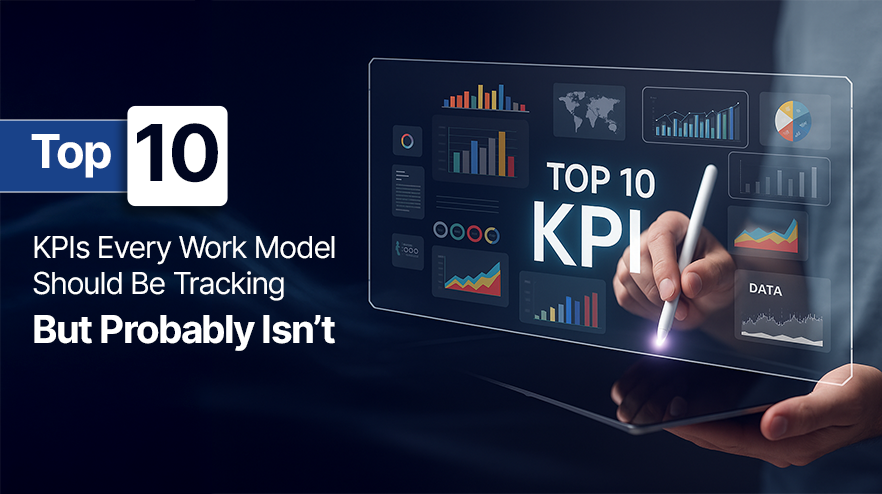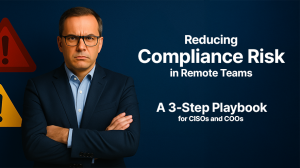Table of Contents
Every leader knows Key performance indicators (KPIs) are essential. In a fast-paced, digitally-driven, and result-oriented business landscape, almost every metric seems important to track but may not offer meaningful insights into performance.
Tracking irrelevant KPIs is not just time-wasting and frustrating; it clouds your decisions, drains your team’s focus, and hides what truly moves the needle.
When measured rightly, key performance indicators for work models are measurable parameters that tell if your efforts and outcomes are aligned with business goals allowing you to evaluate progress, optimize performance, and boost decision-making.
Businesses that monitor the right KPIs experience consistent higher ROI, better results, and sharper execution that sets them apart from the competition. However, many leaders struggle to measure the right performance indicators. But it should not be like this.
Here are 10 KPIs every business should measure regardless of their work model:
1. Focus Time vs Fragmented Time
Focus Time refers to uninterrupted blocks of time where employees engage in deep, meaningful work without distractions. Fragmented Time, on the other hand, is when attention is constantly split—between meetings, emails, pings, or task-switching—leaving little room for real progress.
It’s not the number of hours worked that drives outcomes—it’s how those hours are spent. Employees need mental space to produce high-quality work, solve problems, and think creatively. When their time is fragmented, productivity drops, mistakes increase, and burnout quietly builds up.
Tracking this KPI to measure employee performance helps identify whether your team has the environment and structure they need to stay focused or if they’re stuck in a loop of shallow tasks and constant interruptions.

Automate KPIs Tracking with wAnywhere’s AI-powered Monitoring Solutions Efforlessly
Monitor productivity and compliance on one platform. Track real-time employee activity, compare performance metrics, and access micro-to-macro data to optimize workflows and decisions.
2. Meeting Recovery Time
Meeting Recovery Time is the amount of time it takes for an employee to regain focus and return to productive work after a meeting ends. It’s often an invisible cost that silently eats into your team’s output.
Meetings aren’t just about the minutes they occupy—they impact what comes after too. Constant meetings, especially those that are poorly structured or unnecessary, break flow, disrupt concentration, and leave employees mentally scattered.
If your team spends most of their day jumping between calls, even their “free” time becomes unusable. Work gets pushed to odd hours. Deadlines get tighter. Creativity takes a back seat.
By tracking Meeting Recovery Time, you’ll understand the real cost of your meeting culture—and whether it’s enabling action or stalling it.
3. Digital Tool Overload Score
Digital Tool Overload Score measures the number of tools an employee interacts with daily and how often they switch between them. It gives you visibility into tool fatigue, inefficiencies, and friction in your digital workflows. It also identifies if you are spending budgets on apps with no returns. Every app promises efficiency, but too many tools can have the opposite effect. When employees toggle between 8–10 platforms just to get one task done, it slows execution, breaks focus, and leads to cognitive fatigue.
Worse, important information gets scattered, collaboration becomes chaotic, and onboarding new hires turns into a nightmare. What looks like a productivity boost on the surface can actually be draining your team behind the scenes.
When you track this KPI, you can identify which tools add value and which ones just add noise. It helps teams cut the clutter, reduce redundant tools, save unnecessary licensing costs, and build smoother, more intuitive workflows. The right employee productivity monitoring software makes this process even more efficient by offering clear insights into tool usage and impact.
4. Workload Equity Index
Workload Equity Index measures how fairly work is distributed across individuals and teams. It considers volume, complexity, deadlines, and the context in which tasks are assigned—not just the number of tasks.
Not all workloads are created equal. While one team member might be juggling high-stakes deliverables, another could be coasting with repetitive, low-impact work. Over time, this imbalance leads to quiet burnout, disengagement, or resentment—especially when it goes unnoticed.
Tracking this KPI helps leaders move beyond surface-level task tracking and understand the real weight of what employees are carrying. It ensures that effort and expectations are fairly distributed, preventing overload for some and underutilization for others. Prioritizing this KPI will ensure reduced employee burnout and absenteeism, higher engagement and morale across teams, improved collaboration and accountability, better retention of top performers, and more accurate forecasting and resource planning.
5. Manager Responsiveness Score
This parameter measures how quickly and consistently managers respond to their team’s queries, feedback, blockers, or approvals. It reflects how accessible and supportive leadership is in the day-to-day workflow.
Inconsistent or poor responsiveness can also make team members feel undervalued, unheard, or directionless, especially in remote or hybrid setups where face time is limited.
When businesses track this employee performance KPI, it holds leadership accountable to be present and responsive—not just available in theory. It helps improve team agility, reduces bottlenecks, and fosters a culture where employees feel supported, not stuck waiting.
KPI tracking for managers plays a crucial role here. Tracking this KPI helps you make faster decisions, increase team trust and morale, and align strategy with execution. Since managers are the backbone of workflows, ensuring you’re tracking this KPI not only maintains consistency (from top to bottom) in workflows but also facilitates a healthier feedback loop between you and your managers.
6. Proactive vs Reactive Work Ratio
Proactive vs Reactive Work Ratio measures how much of your team’s time is spent on planned, strategic work versus reacting to last-minute requests, fire drills, or urgent-but-unimportant tasks. If your team is constantly reacting, they’re not creating. They’re stuck in a loop of urgency—solving today’s problems instead of building tomorrow’s results.
While some level of reactive work is inevitable, too much of it signals a deeper issue: lack of planning, unclear priorities, or poor cross-functional communication. Over time, this reactive culture leads to burnout, poor quality work, and missed opportunities for innovation.
When you track this ratio, it reveals whether your teams are operating with intention or just trying to keep up. It helps you shift from firefighting to future-building by enabling better planning, stronger prioritization, and smarter delegation. In addition, tracking this KPI leads to better quality output, higher employee satisfaction, more room for strategic work, and smarter use of time and energy.
7. Output Quality per Hour
Output Quality per Hour measures the standard of work delivered relative to the time spent on it—helping you understand not just how fast your teams work, but how well they deliver.
Speed alone doesn’t guarantee results. A high volume of rushed or low-quality work can create rework, frustration, and customer dissatisfaction. On the other hand, when teams consistently deliver quality in a reasonable time frame, it shows efficiency, clarity, and competence in execution.
Tracking this metric encourages teams to optimize how they work, not just how much they work. It shines a light on where time is used effectively versus where it leads to mediocre results or missed expectations. It helps leaders see where real value is being created—and where effort is being wasted on mediocre or misaligned outcomes. It also brings attention to over-performers who quietly uphold quality without overtime, and to inefficiencies masked by busyness.
8. Async Communication Effectiveness
In remote and hybrid work models, asynchronous communication is the backbone of collaboration. But when async messages are vague, overly long, or lack context, they trigger endless back-and-forths, misunderstandings, and delays.
If this metric is not monitored over time, work stalls while people wait for clarification, duplicate efforts pile up, and team alignment starts to erode.
Measuring this KPI helps teams build a culture of clarity, autonomy, and trust. It encourages thoughtful, self-contained updates that reduce noise and empower action. Effective async communication empowers people to move forward without hand-holding. It reduces dependency, preserves focus time, and ensures work doesn’t stop just because someone’s offline or in a different time zone.
9. Work Environment Risk Score
It is important to measure how safe, secure, and distraction-free an employee’s work environment is—especially in remote and hybrid setups. It includes factors like data exposure risks, noise/disruption levels, unauthorized device usage, or even visible compliance violations (like shared screens or unattended devices).
Just because someone is “logged in” doesn’t mean they’re working in a space that supports focus, security, or compliance. For roles that deal with sensitive data or require deep concentration, the environment plays a critical role in both output quality and organizational risk.
Inconsistent or risky work environments silently weaken performance, increase errors, and expose businesses to security breaches, especially in industries like IT, BPO, or finance.
Tracking this KPI allows leaders to identify potential risks early—before they spiral into security breaches, compliance failures, or reputational damage. It brings visibility into the invisible: what’s happening behind the screen in decentralized workspaces.
Whether its sensitive information being accessed in public spaces, files shared from personal devices, or employees working in chaotic, high-distraction environments—these risks don’t show up on performance dashboards. But they silently erode quality, trust, and client confidence.
10. Employee Sentiment vs Output Correlation
Employee Sentiment vs Output Correlation tracks the link between how employees feel and the quality or consistency of their performance. When employees feel motivated, supported, and emotionally safe, they don’t just perform—they thrive. But when morale dips, it often leads to quiet disengagement, missed deadlines, or declining work quality. This KPI reveals the hidden drivers behind performance highs and lows.
Tracking this KPI helps you move from guesswork to real insight. Instead of reacting after someone burns out or silently checks out, you can spot the signs early—and do something about it. You’ll start seeing patterns: which teams are coasting through with low motivation, and which ones are firing on all cylinders because they feel good about their work.
By using key performance indicators for employees, leaders gain clearer visibility into engagement and output trends. This awareness empowers them to create healthier, more resilient teams where performance isn’t driven by pressure, but by purpose. It builds a culture where people know their well-being matters, and in return, they give you their best work.
How to Implement These KPIs Without Overwhelming Your Team

Measuring too many things too quickly can do more harm than good. You don’t want your team to feel like they’re under a microscope or buried in reports. The goal isn’t to track for the sake of tracking—it’s to create clarity, not chaos. That’s why it’s important to focus on what truly matters when considering how to measure KPI for employees effectively and meaningfully.
So how do you bring these 10 KPIs into action—without overwhelming your people or your processes?
1. Start with what matters most to your business model
Not every KPI needs to go live on day one. Pick 3–4 KPIs that align most with your current priorities—whether it’s productivity, engagement, risk, or output quality. Build focus first, then expand.
2. Integrate KPI tracking into existing workflows
Don’t make people chase new tools or dashboards. Leverage platforms your teams already use—like project management tools, HR systems, or communication platforms—to capture the data passively or with minimal effort. Simplicity wins adoption.
3. Be transparent about the ‘why’
People resist measurement when they think it’s about control. But when they understand it’s about removing blockers, improving clarity, and enabling better outcomes—they get onboard. Share how these KPIs help everyone win: less rework, clearer priorities, stronger results.
4. Automate where possible
Use analytics tools that can track trends, sentiment, or usage in the background. Manual tracking leads to fatigue. Automation brings consistency—and frees up your team’s time to focus on what actually matters: doing great work.
5. Review together, not in silos
Use KPIs to start conversations, not close them. Review insights as a team—ask what’s working, what’s off, and what needs support. This shared ownership turns data into decisions, not just numbers on a slide.
Read more: How To Measure & Monitor Employee Productivity
Bottom Line
Most businesses don’t struggle because they’re not tracking enough. They struggle because they’re tracking what’s easy—what’s visible, what’s familiar—not what truly reflects progress or performance.
Hours worked, attendance logs, and surface-level productivity metrics might give you a sense of activity, but they rarely tell the full story. The real performance drivers often sit deeper: the quality of output, the clarity in communication, emotional wellbeing, or risk factors silently affecting work.
If you want better outcomes, sharper execution, and more aligned teams—you need better input. And that starts with choosing the right KPIs. Start small. Pick the 3–4 KPIs from this list that resonate with your current work model. Integrate them into your weekly or monthly check-ins. Don’t aim for perfection—aim for visibility. Over time, layer in more.
Because tracking the right KPIs isn’t about adding more data. It’s about removing guesswork. Tools like wAnywhere help teams track meaningful metrics in real time, driving accountability and performance. The sooner you start, the sooner you unlock a work culture that’s more focused, more consistent, and more in control of its outcomes.

Get Your Custom KPI Dashboard Today
Start tracking what really drives performance with wAnywhere’s one-stop solution for productivity monitoring, compliance tracking, and team management.
FAQs
What is a KPI in the workplace?
A KPI (Key Performance Indicator) is a measurable value that shows whether work efforts are aligning with business goals. In simple terms: it tells you what’s working, what’s not, and where to focus. Good KPIs bring clarity, drive accountability, and help teams improve performance over time.
How can AI help track KPIs more effectively?
AI helps by automating data collection, spotting trends, and generating real-time insights—without manual effort. For example, it can analyze communication patterns, flag risk-prone work environments, or predict burnout using sentiment signals. This means faster decisions, fewer blind spots, and a smarter way to manage performance.
What happens if your team isn’t tracking the right KPIs?
You end up focusing on surface-level activity instead of meaningful progress. It leads to unclear priorities, wasted effort, and poor decision-making. Teams feel busy but directionless. Over time, this misalignment weakens results, drains morale, and leaves leadership flying blind.
What KPI mistakes do most companies make?
Most businesses aren’t able to figure out what KPIs are right to track for their goals and teams. They tend to track parameters that are easy but not useful. In addition, businesses track too many metrics that can result in losing their direction. Therefore, rather than using KPIs to drive clarity and growth, they use it for micromanagement.
What are examples of actionable KPIs for hybrid teams?
The examples of actionable KPIs for hybrid teams includes,
- Async Communication Effectiveness – shows how clearly teams collaborate across time zones.
- Digital Tool Overload Score – highlights app fatigue and tool chaos.
- Work Environment Risk Score – flags distractions or compliance risks in remote setups.
- Sentiment vs Output Correlation – helps connect mood with performance in distributed teams.
These KPIs give hybrid teams visibility into what’s really affecting their flow, focus, and outcomes.












